Juno Beach – Understanding the Role Canadians Played at D-Day
It’s day four of the Liberation Tour 2015 and as Ed Sullivan would say, we are headed for “the really big shew”, Juno Beach and the Canadian landings on D-Day. When I use the words ‘Understanding Juno Beach’, I mean it, as my previous knowledge of exactly what was involved in the Allied landings on D-Day was ill informed at best and ignorant at worst. One needs to be here on the ground to get an appreciation of the scope and size of the D-Day operations and to understand the incredible courage of the men from Canada and eleven other countries that hit the beaches on June 6th, 1944.
D-Day Landings
Before coming here I always had this idea that there were five different beaches at which troops landed and hey, a beach is a beach right? Wrong. Each of the five so-called beaches are actually huge sectors containing in some cases many individual beaches. The total area covered by the five ‘beaches’ stretches fifty miles (80 kms)! Here’s a map showing the total D-Day landing area. Starting from left to right the arrows point to Utah, Omaha, Gold, Juno and Sword beaches. Today we are concerned only with Juno Beach which is the one the Canadians were put in charge of taking.
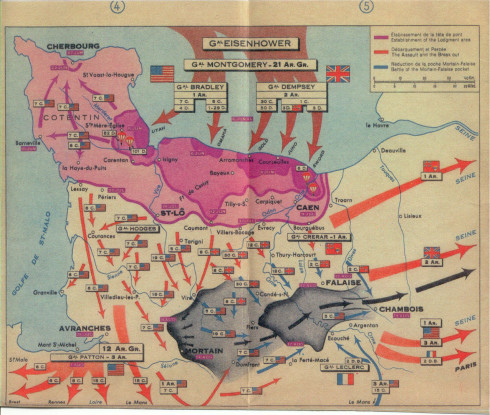
Here is a map showing only the operations at Juno Beach.
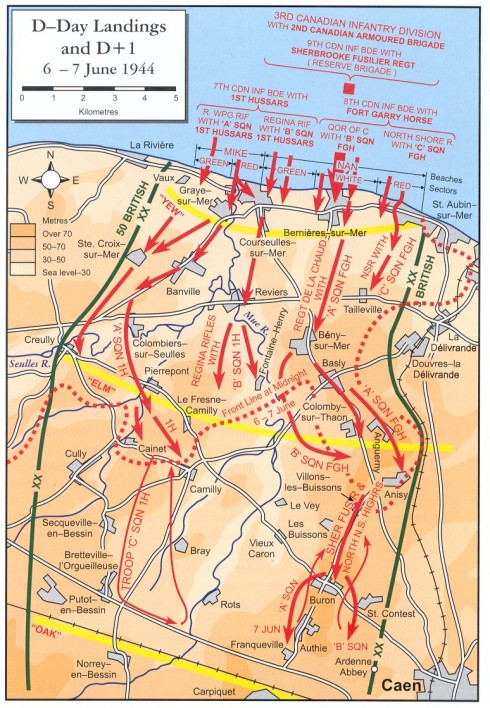
Juno Beach
Looking at the scale you can see that the Juno Beach landings alone covered an area over three miles (5 kms.) long and four separate communities, Graye-sur-Mer, Courseulles-sur-Mer, Bernieres-sur-Mer and St. Aubin-sur-Mer. You can also see that Juno Beach was divided into the Mike and Nan Beaches which were in turn were divided into Green and Red sectors for Mike and Green, White and Red sectors for Nan. Each of these sectors was attacked by different Canadian Regiments and each has their own stories of heroism, sacrifice, setbacks and success. We will visit all of them today with historian Phil Craig and tour director John Cannon. The starting point is the Juno Beach Centre at Courseulles-sur-Mer.
The centre was opened only in 2003 and was built totally through funds raised from private individuals and organizations – more on that later. The government of Canada did not have the foresight to realize how important it was to commemorate the huge sacrifice Canadians made here on D-Day, but no doubt politicians today trip over themselves to get taxpayer funded junkets for photo ops at this hallowed site, but enough about that. I’ll try to stay focused on the ones that matter.
Before entering the centre we get a guided tour of the bunkers, observation posts and tunnels where the Germans lay in wait for the Canadian troops. It is led by Scott Entwistle from Kelowna, B.C. who is part of the Student Guide Program sponsored by the Juno Beach Centre. The few students who are accepted get an extensive stay in France while learning more about Canada’s role in D-Day. Scott did an excellent job of supplementing the information we were given the day before by Phil about the Atlantic Wall. Here’s Scott giving a presentation.
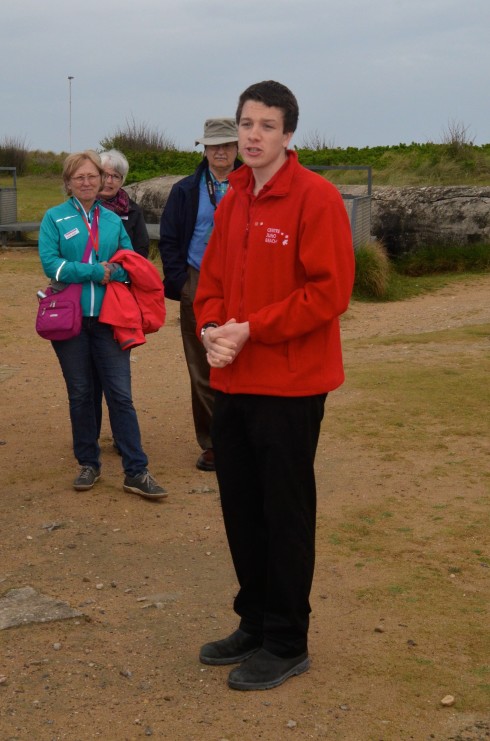
Next we entered the bunkers and lookout post where Scott pointed out what looked like an innocuous small hole on the exterior of the bunkers. These in fact were a new type of ventilation shaft that was designed to be impervious to grenades. Before these shafts were invented the bunkers were vulnerable to grenades being tossed through the ventilation holes and apparently several Canadian soldiers mistook them for the traditional type of shaft and the grenades they placed in them blew up, not in the bunker, but just a few feet from the soldiers.
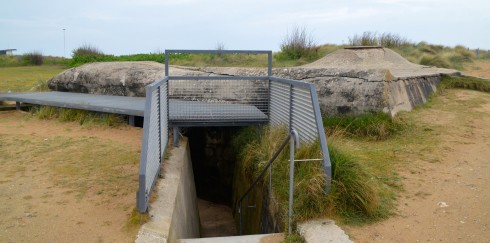
The tunnel system at Juno Beach was extensive and despite massive shelling just prior to the landings, the defensive system remained largely in place. Here are my two sisters emerging from the tunnels – a more pleasant site than the Canadians faced on D-Day.
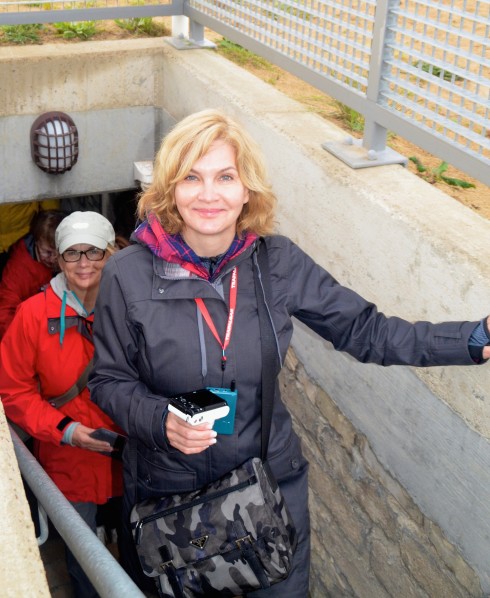
After Scott finished his tour of the fortifications Phil took over and gave us a stirring build up to the landings.
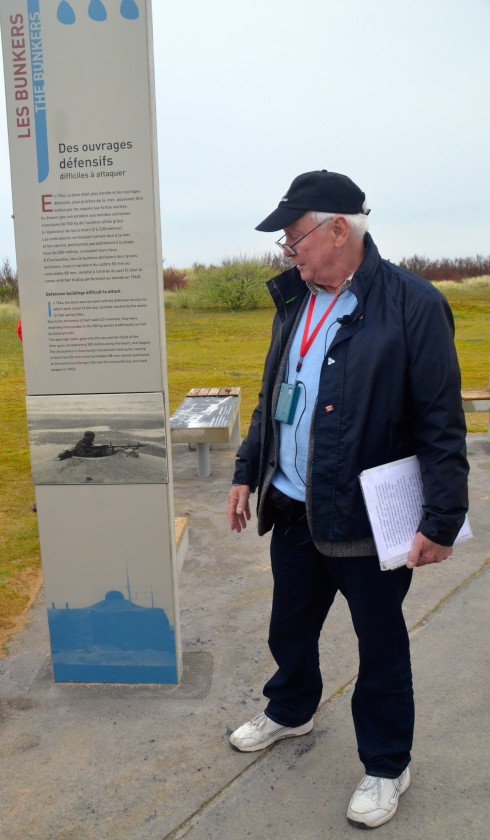
And at last, we walked to the beach and saw where some of the 14,000 men from the 3rd Canadian Division went ashore on D-Day. The 3rd was comprised of the 7th, 8th and 9th Infantry Brigades which in term were each composed of three regiments. There were also over a dozen more support units. On this particular spot where we first enter Juno Beach the Winnipeg Rifles aka The Little Black Devils, led the way, landing well in advance of their support vehicles and here’s what they found as written in the Regimental War Diary “The bombardment having failed to kill a single German or silence one weapon these companies had to storm their positions ‘cold’ and did so without hesitation”.
As we walk what is really a beautiful beach, Phil reads from Regimental diaries and recreates for us the almost impossible odds the Winnipeg Rifles faced that day and yet, after a 75% casualty rate, they succeeded – the bunkers were silenced and the beach was safe for the other troops and material that followed. That day the beach ran red with Manitoba blood and today it looks so serene that unless you knew what had happened here, it would be impossible to imagine.
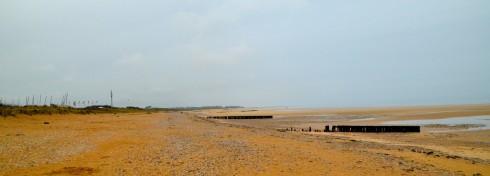
Further down the beach behind the community of Graye-sur-Mer we arrive at the Cross of Lorraine, symbol of the Free French Forces and marking the spot where General De Gaulle came ashore.
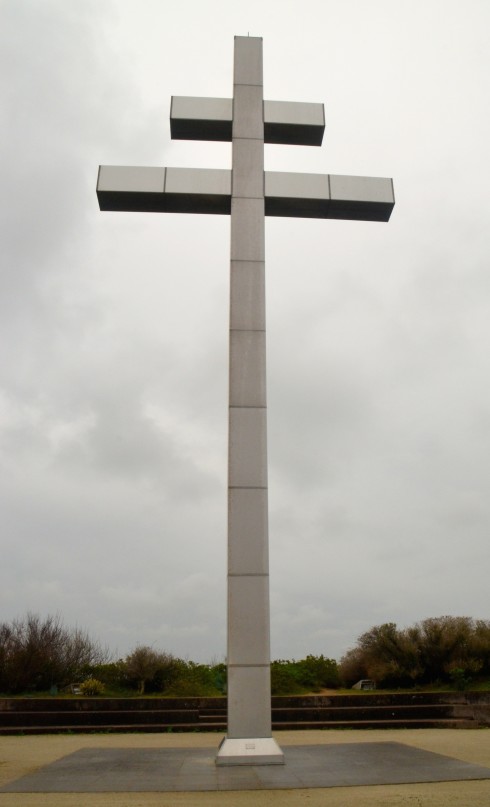
However, before De Gaulle could land the site was secured by the Canadian Scottish Regiment, the Princess Mary’s, from Victoria. We crossed back over the dunes here to return to the Juno Centre and on the other side was this funny looking tank.
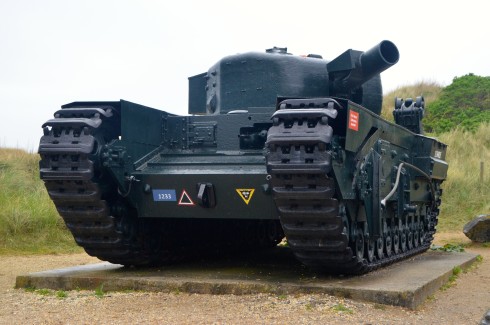
Phil confirmed that it indeed was a funny looking tank and was one of a number of tank modifications designed by British military engineers and generally called Hobart’s funnies after Percy Hobart, the commander who designed most of them. This one was designed for busting bunkers.
Juno Beach Centre
We retuned to Juno Beach Centre where we apparently were expected.
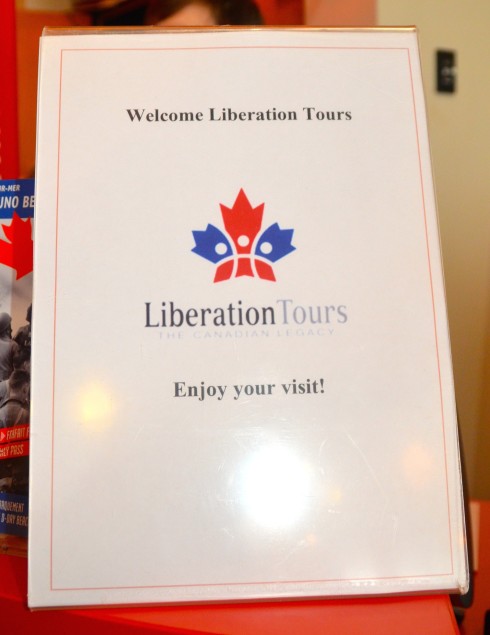
Before going in John took this group photo.
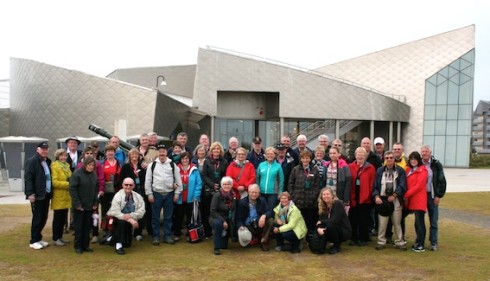
As you can see the Juno Centre is a beautiful looking building that reminded me of Frank Gehry’s work, but it’s by another Canadian architect, Brian K. Chamberlain who has incorporated a number of Canadian symbols into the design.
The centre itself tells the entire story of WWII from the Canadian perspective. You enter through a small theatre that is shaped like one of the D-Day landing craft and a four minute film makes you feel like you are in one. It was somewhat of a relief to have the doors open and step into the exhibits. This post would go on forever if I described the exhibits in detail, but two truly struck me. The first is a moving scroll on the ceiling just before you leave that has the names of every Canadian killed in WWII. It takes thirteen and a half hours to complete. I stood there mesmerized as the name of all the Wilson’s killed went slowly by. It took over three minutes and I counted 16 William Wilson’s alone. It’s powerful stuff and I couldn’t help but choke up.
Just as moving is the 12 minute film They Walk with You which shows many of the men who went ashore at Juno Beach in group photographs taken in the days leading up to the attack. Most of them are smiling, engaged in horse play or otherwise acting like young men in groups do – and then some of the faces start to fade away. These are the ones that will die in the next few days. I have tears in my eyes as I write this.
For some reason war memorials seem to bring out the best in sculptors, architects, painters and writers. It’s about the only good thing that can be said about war and that’s because it’s after the fact. These guys didn’t start a war so they could write about it or memorialize it in stone. It had already happened. The sculpture just outside the Juno Centre, Remembrance and Renewal by Colin Gibson, I think falls into this category. To my mind it is a great piece of art and says far more in its simplicity than might a more detailed work.
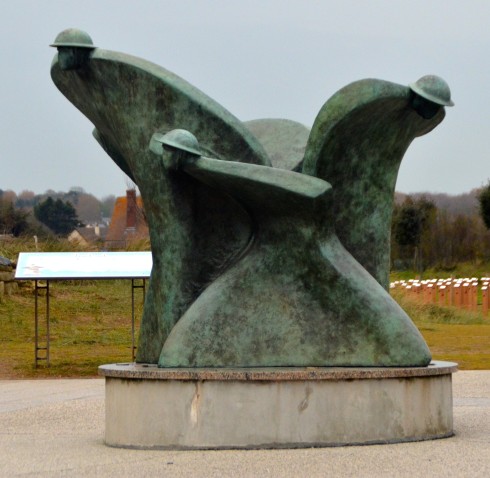
Getting back to the volunteers and private donors who got this place built there are hundreds of small plaques to the donors just on the other side of the entrance.
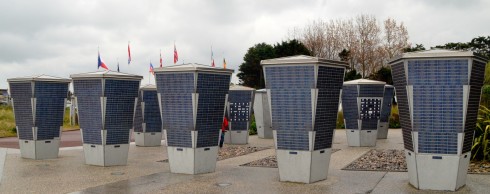
I was pleased to find this one. John and Phil had made a donation on our behalf which came out of the money we had each paid for the trip. They didn’t have to do this and it wasn’t listed as something included in the price of the tour, so really it came out of their pockets. Thank you John and Phil.

It had been a very emotional morning and we needed a break and headed into Courseulles-sur-Mer for lunch. Today it is a fishing village and there was a fish market where a great variety of fish and shellfish was available, all fresh from the ocean that morning. It was a welcome diversion.
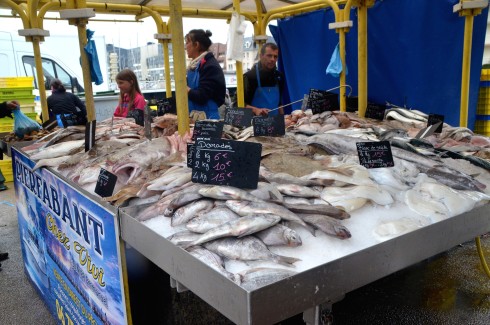
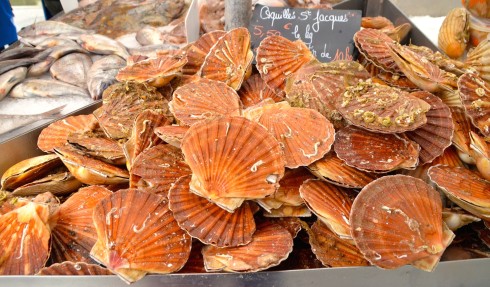
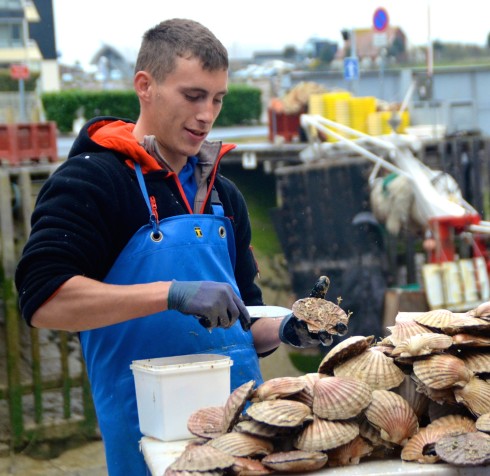
And here’s a turbot, a fish that we almost went to war with Spain over.
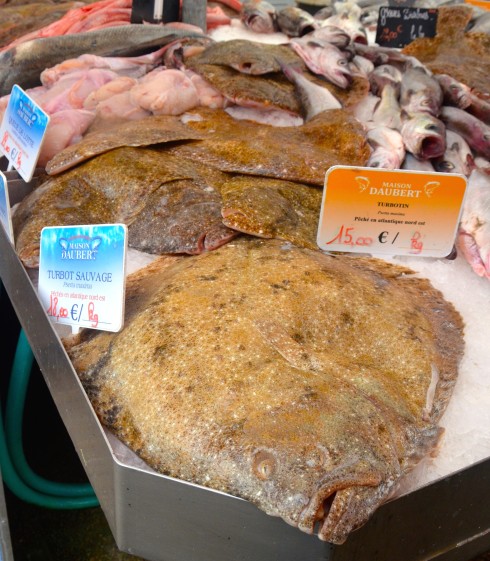
I couldn’t help but notice this fishing boat high and dry at low tide.
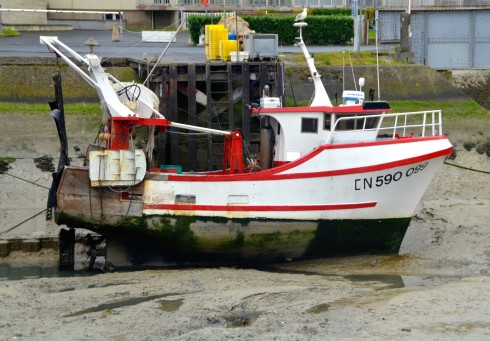
Still reminders of the war are never far away in Courseulles-sur-Mer. This is a Duplex Drive modification of a Sherman tank that the Canadians used at Juno Beach.
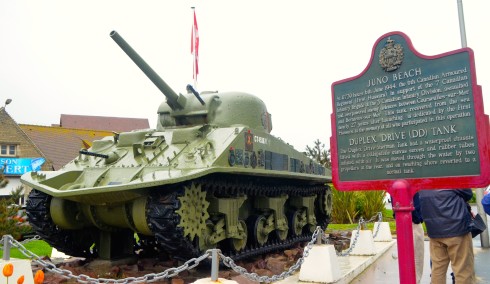
Attached to it were the badges of all the regiments that participated in the Juno Beach landings including this one of the North Nova Scotia Highlanders aka North Novas in which Alison’s uncle John Weir served and landed on D-Day.
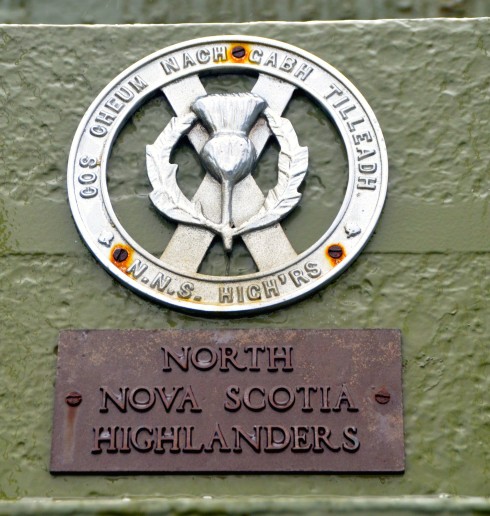
After lunch we walked back to the bus and the fishing boat was refloated.
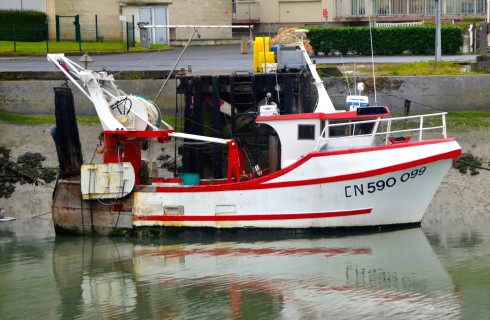
St. Aubin-sur-Mer
Fortified with some great seafood we were ready to visit the Nan sector of Juno Beach starting at St. Aubin-sur-Mer where the landing was led by the North Shore (New Brunswick) Regiment. The beach here is quite different than that at Courseulles-sur-Mer as there is a seawall and houses just behind it.
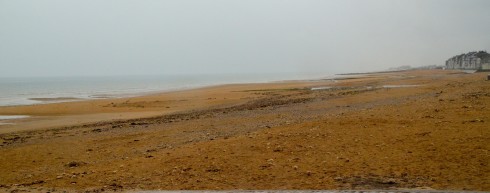
The biggest problem for the New Brunswicker’s was a 50mm battery right beside the seawall.
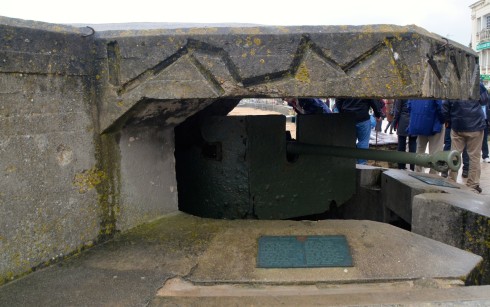
It was positioned so that it could fire on anyone attempting to get over the seawall and was very deadly. The father of one of the members of our group was here that day and two of his best friends were killed by this battery.
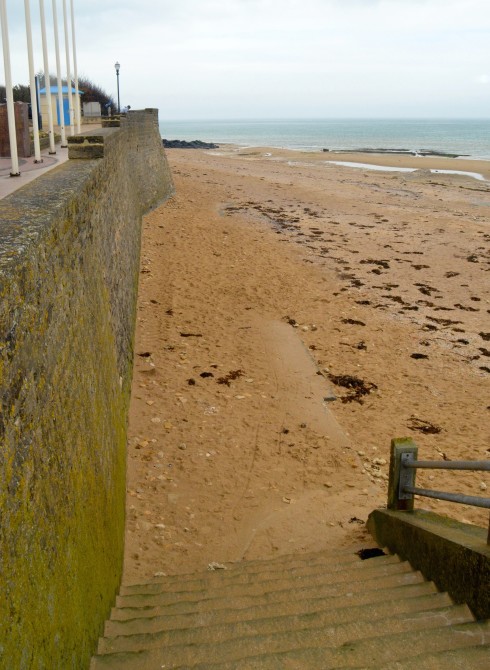
To add to the horror that day the Germans in the battery put out a white flag and as the New Brunswicker’s approached to accept their surrender opened up on them and it was a slaughter. Needless to say when the battery was finally taken there were no German survivors. The bastards deserved to die and I don’t say that lightly.
Bernieres-sur-Mer
We then moved on to the center of Juno Beach at Bernieres-sur-Mer where the Queen’s Own Rifles from Toronto led the assault. Like St. Aubin, Bernieres had houses in which snipers could hide and wreak havoc.
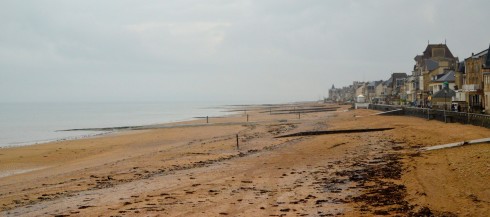
In what was becoming a familiar refrain, the German defenses had barely been scratched by the aerial and naval bombardments. Over 100 Torontonians were killed within sight of this building, known forever since as Canada House.
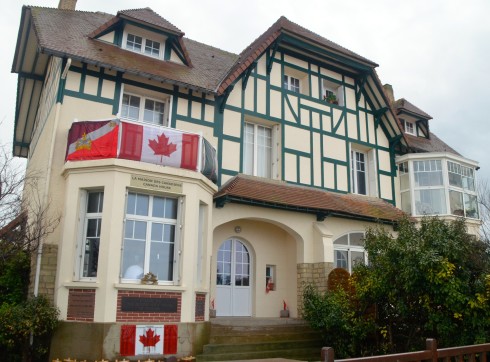
Nearby is this monument to the Queen’s Own Rifles.
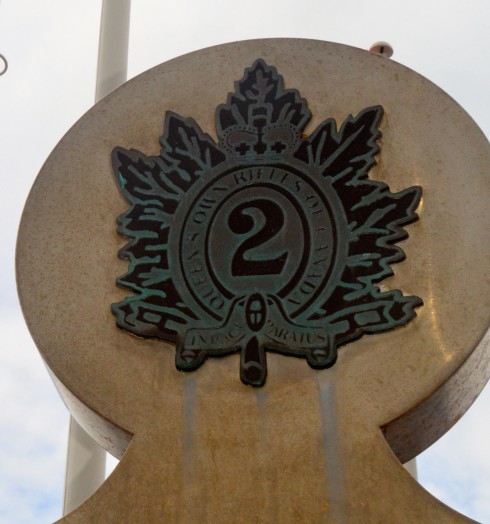
The visit ended on a less sombre note as a little girl in Canada House waved at the group as we listened to Phil narrate the story of the QOR’s.
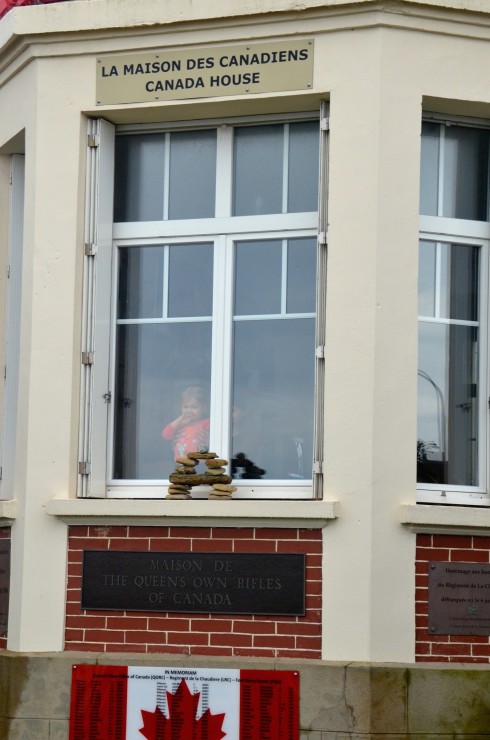
Despite the huge losses the Canadians achieved their objectives on D-Day and advanced further into Normandy than any other attacking force. It was our finest hour.
Next we will visit Beny-sur-Mer Cemetery where many of those who died taking Juno Beach are interred. It won’t be an easy visit, but it must be done. Please join us.

